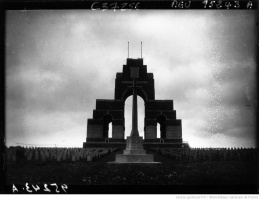Purpose↑
After the Armistice, the Imperial (now Commonwealth) War Graves Commission created cemeteries to mark the burial places of those who had died while serving with the armed forces of the British Empire. To commemorate those with no known grave, the Commission constructed memorials to the "missing": those whose bodies had not been recovered; those whose graves had been unrecorded, lost or destroyed by battle; or those whose remains could not be identified and had been buried beneath a headstone bearing the inscription "Known Unto God." Some eighty-five such memorials were raised across the world. Those built in France bear 218,000 names.
The Thiepval Memorial is dedicated to "The Missing of the Somme": more than 72,000 British and South African soldiers who were killed in the region between July 1915 and March 1918. It was designed by Sir Edwin Lutyens (1869-1944), architectural advisor to the Commission, who had created several other prominent cemeteries and memorials including the Cenotaph in London. Construction at Thiepval began in 1928 and the memorial was officially inaugurated on 1 August 1932, when the Prince of Wales, later Edward VII, King of Great Britain (1841-1910), expressed the Commission’s determination to honour the dead by "material expression...as enduring as human hands and human art can make it."
Design and Architecture↑
Originally raised in the bleak landscape above the Ancre, the memorial is now surrounded by mature trees and countryside. Standing some fifty metres high, it takes the form of a series of arches, interlocking at right-angles, rising to a tower. It was built largely with locally-sourced red bricks, many of which were later replaced by specially-engineered substitutes to help prevent erosion. Around the base of each of its sixteen ground-level piers are panels of Portland stone inscribed with names. Remarkable for its singular vision, Lutyens’ design diverges from the classical architecture of most other Memorials to the Missing on the Western Front. Its precise geometry and intellectual imagination subverts and elevates the simple form of the triumphal arch into a meditation on war and loss.
Most of those commemorated on the memorial were killed between July and November 1916, during the Battle of the Somme. Each man is listed by surname and initials, grouped by regiment and rank. Since their initial installation, the panels have been amended to add names or remove those whose remains or graves have been identified. While South Africa agreed to commemorate its 830 missing at Thiepval, other Commonwealth nations named their Somme missing elsewhere: Australia at Villers-Bretonneux, Canada at Vimy, India at Neuve-Chapelle, Newfoundland at Beaumont-Hamel, and New Zealand at Longueval.
Anglo-French Memorial↑
The Thiepval Memorial also serves as a monument to the alliance of France and the British Empire. High on its façade is inscribed, in French, "To the French and British Armies, from the grateful British Empire." A cemetery beneath the memorial is the final resting place of 300 Commonwealth and 300 French soldiers whose remains were recovered from the surrounding countryside. On the Commission’s cross which faces them is the inscription: "That the world may remember the common sacrifice of two and a half million dead, here have been laid side by side soldiers of France and of the British Empire in eternal comradeship."
Glyn Prysor, Commonwealth War Graves Commission
Section Editor: Catriona Pennell
Selected Bibliography
- Crane, David: Empires of the dead. How one man's vision led to the creation of WW1's war graves, London 2013: William Collins.
- Harris, John / Stamp, Gavin / Heinz Gallery: Silent cities 1914-1919. An exhibition of the memorial and cemetery architecture of the Great War, London 1977: Royal Institute of British Architects.
- Hussey, Christopher: The life of Sir Edwin Lutyens, London; New York 1950: Country Life; Scribnerʼs.
- Longworth, Philip: The unending vigil. A history of the Commonwealth War Graves Commission, 1917-1967, London 1967: Constable.
- Stamp, Gavin: The Memorial to the missing of the Somme, London 2006: Profile Books.








